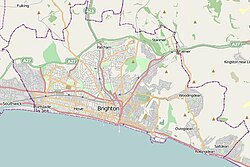Adelaide Crescent
| Adelaide Crescent | |
|---|---|

The east side of the crescent
|
|
| Location | Adelaide Crescent, Hove, Brighton and Hove, England |
| Coordinates | 50°49′29″N 0°09′50″W / 50.8247°N 0.1640°WCoordinates: 50°49′29″N 0°09′50″W / 50.8247°N 0.1640°W |
| Built |
|
| Built for | Sir Isaac Goldsmid, 1st Baronet |
| Architect | Decimus Burton |
| Architectural style(s) | Regency/Italianate/Renaissance Revival |
|
Listed Building – Grade II*
|
|
Official name:
|
|
| Designated |
|
| Reference no. |
|
|
Listed Building – Grade II
|
|
Official name:
|
|
| Designated | 2 November 1992 |
| Reference no. |
|
|
Location within Brighton and Hove
|
|
Adelaide Crescent is a mid-19th-century residential development in Hove, part of the English city and seaside resort of Brighton and Hove. Conceived as an ambitious attempt to rival the large, high-class Kemp Town estate east of Brighton, the crescent was not built to its original plan because time and money were insufficient. Nevertheless, together with its northerly neighbour Palmeira Square (with which it is continuous), it forms one of Hove's most important architectural set-pieces. Building work started in 1830 to the design of Decimus Burton. The adjacent land was originally occupied by "the world's largest conservatory", the Anthaeum; its collapse stopped construction of the crescent, which did not resume until the 1850s. The original design was modified and the crescent was eventually finished in the mid-1860s. Together with the Kemp Town and Brunswick Town estates, the crescent is one of the foremost pre-Victorian residential developments in the Brighton area: it has been claimed that "outside Bath, [they] have no superior in England". The buildings in the main part of Adelaide Crescent are Grade II* listed. Some of the associated buildings at the sea-facing south end are listed at the lower Grade II.
Adelaide Crescent is immediately behind Hove seafront, bounded by Kingsway (the coast road) to the south and Palmeira Square to the north. The earlier Brunswick Town estate of Brunswick Square, Brunswick Terrace and its associated buildings are to the east. It developed at the west edge of the Wick Estate, whose western boundary is the present St John's Road. This 250-acre (100 ha) estate, based on a farm of the same name, covered open land east of Hove village as far as the parish boundary with Brighton. Although it was within Hove parish, the crescent and Brunswick Town were originally considered "scarcely part of Hove at all", because they were distant from the village but adjoined the western edge of Brighton. Furthermore, their architectural character aligned them more closely with Brighton, as did their historical associations.
...
Wikipedia

